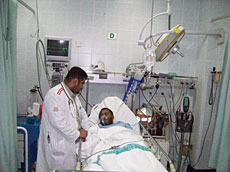JEDDAH: Restricted-use pesticides have struck again. This time four Bangladeshi workers were rushed yesterday to Jeddah’s King Fahd Hospital after showing symptoms related to phosphine gas poisoning.
Three of the men are in their 30s and one of them is 41. Few details were available yesterday regarding how these men, identified by hospital staff only as “workers,” came to be exposed to the poison.
“One of the poison victims is receiving intensive treatment as his case is critical. The condition of the other three victims is better,” said Dr. Mahmoud Abdul Jawad, director of emergency room in the hospital.
Jawad told Arab News that laboratory tests confirmed that the poison came from a pesticide containing aluminum phosphide — the same chemical identified in the deaths of two Danish children at Jeddah’s Al-Basateen Village on Feb. 23 and which is suspected in myriad other deaths in recent months.
Police are investigating the accident while the Civil Defense launched an investigation at the building where the workers were poisoned.
The latest reported pesticide poisoning comes 10 days after a similar incident in Jeddah took the lives of a six-year-old girl and her three-year-old brother, the children of Frederick and Dorthe Skad. Investigators are in the process of looking into how phosphine gas spread into the Skads’ apartment from a vacant and recently fumigated unit next door. Pesticides containing aluminum phosphide are categorized as “Restricted Use Pesticides” (RUPs) by the US Environmental Protection Agency. The UN’s Food and Agriculture Organization has for years warned about the widespread availability of RUPs in many countries worldwide.
RUPs are prohibited for use in domestic habitations. When exposed to water, aluminum phosphide (and magnesium phosphide) releases phosphine gas that kills insects and other vermin. It is often used in grain storage facilities because the gas leaves no residue on foodstuffs.
Phosphine gas is so dangerous to humans it was tested as a chemical weapon during World War I, according to the book “Weapons of Mass Destruction: An Encyclopedia of Worldwide Policy, Technology and History,” by Eric Croddy and James J. Wirtz. Phosphine gas is odorless, although the byproduct releases a garlic-like odor that can be smelled at high concentrations.
According to a crop fumigation manual published by the US University of Minnesota, exposure to lethal doses of phosphine gas is possible without smelling an odor.
Symptoms of phosphine poisoning include dizziness, numbness, fatigue, breathing difficulties, nausea, vomiting and diarrhea. A few hours’ exposure to the gas can cause death within 24 hours from heart failure.


